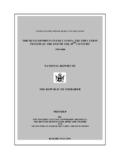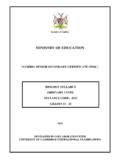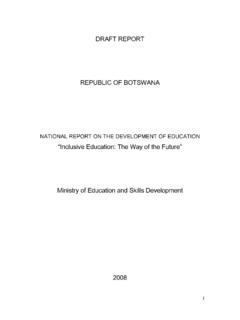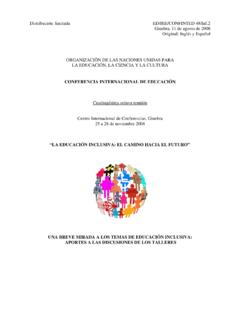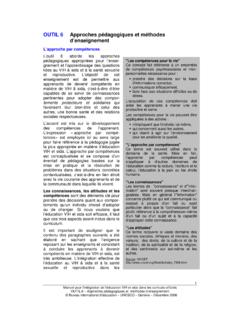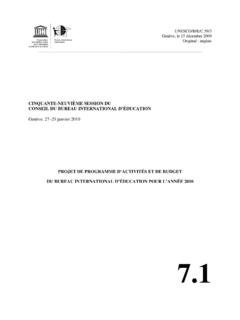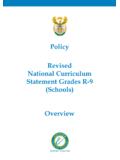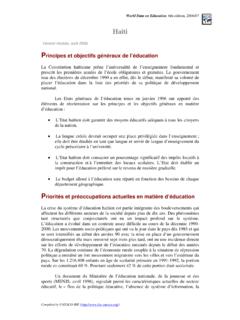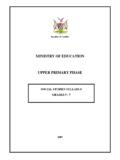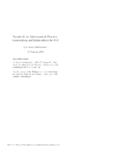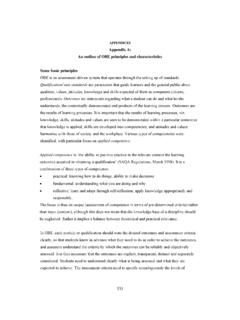Transcription of INTRODUCTION Module 4: Problem Solving
1 IINTRODUCTION Mathematics is conceptualised as the art of understanding and using numbers to acquire and develop numeracy, computational skills, and Problem Solving ability. This Mathematics syllabus is designed for learners from Standards 1 to 4. It is observed that when learners begin school they already have acquired some mathematical knowledge and skills from their environment through daily living activities. Therefore, this syllabus is expected to enhance the knowledge and skills learners already have and build on these to introduce new concepts. The syllabus is organised into modules as follows: Module 1: Numbers and Operations The Module aims at developing learners concepts on numbers and pre number work.
2 It covers Sorting and Classification, Matching, Counting, Addition, Subtraction and Money. Module 2: Geometry The Module deals with geometric flat shapes and solids. Learners will identify flat shapes such as squares, rectangles, triangles and circles. They will also identify solids such as cubes, cuboids, cylinders and spheres. Module 3: Measures The Module intends to develop in learners the skill in measuring length, area, mass, capacity and time. The learners will compare, estimate and measure objects in the environment using non standard and standard instruments and units. Module 4: Problem Solving The Module introduces learners to activities such as playing mathematical games, Solving simple puzzles, carrying out simple investigations and Solving real life, non - routine and challenging problems.
3 The activities will serve as a basic form of INTRODUCTION to real Problem Solving . The Module will also help learners realise that mathematics is not abstract but has a variety of functional applications in their own lives. Module 5: Statistics The Module involves collecting, recording and representing data in pictographs and bar charts as well as interpreting data given in graphs. The modules are subdivided into topics whose focus is given by general objectives. The general objectives give rise to specific objectives, which describe the behaviour pupils should display after being taught specific content.
4 To address the objectives of this syllabus, teachers are expected to develop activities relevant and accessible to the learner s environment. The activities should be learner centred. Emerging issues are catered for in Statistics where learners would conduct simple survey on HIV / AIDS and the environment. Teachers are expected to use examples of the emerging issues where appropriate in the teaching of this syllabus. This mathematics syllabus is designed and developed on the basis that mathematics would be allocated at least four hours per week in the Primary School timetable. RATIONALE Mathematics plays a key role in everyday life as a communication tool that makes extensive use of symbolic notation.
5 It stirs the intellectual challenge, the outcome of which is cognitive development that assists in sustaining the thinking span. It helps to develop mental processes that enhance logical and critical thinking, accuracy and Problem Solving ; all of which are very important in decision making. iiMathematics provides a foundation for logical and lateral thinking essential in acquiring and organising knowledge, developing concepts and skills, and understanding principles for further learning. It empowers learners to make associations and generalisations, which are important in the study of natural, physical and social sciences as well as in the operation of industry and business.
6 It is also seen in nature and thus helps in the interpretation of the environment. Its study will develop in learners the appreciation of its cultural and traditional development. The subject demands the active participation of learners to explore the world around them through investigation as well as application of learned principles. 1 AIMS OF THE PRIMARY SCHOOL MATHEMATICS PROGRAMME To develop in all learners 1. competence and confidence in the application of computational skills in order to solve day to day problems 2. inquiry skills, creativity, critical thinking and Problem Solving ability 3. an awareness of mathematics as a language to analyse and communicate information and ideas 4.
7 An awareness of the interrelationship of topics within mathematics and with other subjects 5. positive attitudes and values toward mathematics and its integration with other subjects 6. numeracy and literacy skills compatible with technological and scientific developments 7. the ability to demonstrate the use of acquired mathematical concepts and skills in making informed decisions and drawing conclusions 8. appropriate and adequate concepts for further study of mathematics and other related subjects 9. an awareness and appreciation of the role of mathematics in cultural and traditional activities within the environment 10.
8 An awareness of emerging issues in relation to mathematics. ATTAINMENT TARGERTS At the end of four years of primary education every learner should be able to: - Read and write numbers count the number of objects in a set of less than 1000; read and write in numerals any given whole number less than 1000; read and write whole numbers in words less than 1000; read and write multiples of 2, 3, 4, 5 and 10 through 100; classify whole numbers up to 100 into odd, even and multiples; identify, read and write, in numerals, money values through 100 Pula.
9 Find the value of digits in numbers less than 1000; put in order up to five whole numbers less than 1000; using a reference point, identify the ordinal position of any object in a set of no more than 1000; using the correct symbol, (=,<,>), to indicate the correct relationship between two numbers less than 1000 Compute fractions read and write basic fractions; divide a given whole into equal parts: - halves, fourths, fifths, eighths and tenths; identify one-half, one-third and one-fourth of a given region; add two proper fractions having like denominators; subtract one proper fraction from another having like denominators; order fractions with same denominators in terms of size.
10 Carryout basic operations add two 3-digit numbers with carrying given in vertical and horizontal notation giving sum less than 1000; subtract up to 3-digit numbers vertically and horizontally; multiply a 1-digit by a 2-digit or 3-digit number giving an answer below 1000; divide up to a 3-digit number by a 1-digit number with and without a remainder; divide by ten with and without remainder; recognise the relationship among the four basic operations. iiiCarryout and compute measurements use a given unit of measurement (non-standard and standard) to determine the length of an object in whole units; estimate length using centimetres and metres; find perimeter of given shapes and objects; determine length, width, and height by measuring shapes/objects in centimetres and metres; find areas by counting squares; state the days of the week in consecutive order; name the months of the year in consecutive order; state the date by day, month, and year from a calendar; state the dates of special events of the year.
